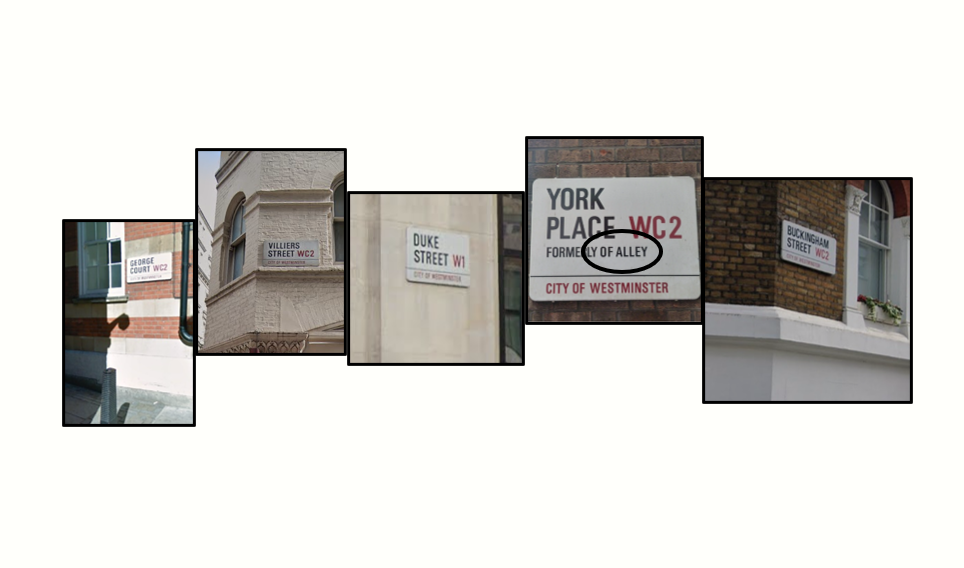March 30, 2020
… wouldn’t be anywhere near so interesting. Here are just a few of my favourite street names from London history.
The story behind the road names shown above is a favourite of mine, and you’ll find it retold on almost every blog about London. To cut a long story short, in 1672 the 2nd Duke of Buckingham sold his London home York House, located on the Strand overlooking the Thames, for redevelopment. As part of the deal the developer had to commemorate the Duke’s name in the roads built on the site. This meant that each of the words George Villiers, Duke of Buckingham needed to be attached to a street.
Now, eagle-eyed readers will spot that I have cheated. The ‘Duke Street’ sign belongs to a road running from Manchester Square to Grosvenor Square, nowhere near the Strand. Sadly for tour guides retelling the story, the relevant Duke Street has been renamed John Adam Street, after one of the architects of the 1772 Adelphi development close by. It is also true that most of George Street has been renamed York Buildings, but with the north end becoming George Court, I think I’m on safe ground there.
However, all this is by the bye. I’ve been thumbing through my copy of Street Names of the City of London, written by Eilert Ekwall, a Swedish academic. He researched old documents referencing the square mile and produced a list of streets mentioned in them – some still existing, some lost. He then attempted to explain the origin of the street names and identify the location of the ones now lost. He could be damning of others’ work; the book is littered with phrases like ‘hardly satisfactory’ and ‘appears to be a guess’ – the ultimate put-down for an academic. Anyhow, here is a very small selection of the best (or worst) of Ekwall’s derivations. Don’t read on if you’re eating.
Named after the activities going on there:
- Do Little Lane. Yes, this really was named after the lack of anything much going on there.
- Turnagain Lane. It was a cul-de-sac …
- Blow Bladder Street. The place to go for those all-important inflated pigs’ bladders.
- Pissinge Alley. Just north of St. Paul’s of all places, this means exactly what you think it means, probably as the result of particularly long sermons.
- Gropecunt Lane. Also means exactly what you think it means. Ekwall helpfully explains to his delicate, academic readers that this is an indecent name, and provides the Latin roots of the separate words to prove it.
Not as bad as you may think:
- Spittle Lane. Thankfully, in this context spittle means hospital.
- Mincing Lane. Near Fenchurch Street. Still very much with us, although the nuns after whom it is named (from the Middle English minchen) are long gone.
Derived from titles:
- Addle Hill South of St Paul’s, this one still exists, and is derived from Ætheling, meaning prince in Saxon times.
- Knightrider Street. Even Ekwall struggles to come up with a plausible explanation for this one, which also still exists and is near Addle Hill. He settles for an accidental double naming, as rider in Early Middle English was a synonym for knight.
Just don’t go there:
- Addle Street. Nope, not another Ætheling derivation. On this occasion Ekwall is much more convinced by the Old English word for filth or liquid manure. I did tell you not to read this if you were eating.
- Pudding Lane. You may have leapt to the conclusion that this was named after some sort of baked pudding, as the 1666 Great Fire of London reputedly started in a bakery here. Wrong Pudding Lane. This one was near Queenhithe and is likely to be a past name for the currently fragrant-sounding Gardners Lane. Pudding in this case comes from a middle English word for ‘bowels, entrails and guts’ as the butchers of Eastcheap carted their offal down the lane to dump it in the Thames.
- Ratones Lane. You can only fear the worst with a name like that, and you’d be right. The name means ‘Lane infested with rats’ in Old English. Just to make you feel even more queasy, this appears to be an earlier name for Pudding Lane, above.
- Stew Lane. This was not a lane in which to purchase your supper. Technically, stew refers to hot baths, but Ekwall spares his readers from the fact that it was also slang for a brothel. The lane, which still exists, goes down to the waters edge from where – in Shakespearean times – it was only a short boat ride across the Thames to the brothels of Southwark.
- Stinking Lane. Now the much less malodorous King Edward Street, running north from Newgate.
And finally, some surprising news on Ludgate Hill. Ekwall conjures a vision of Anglo-Saxons wandering around rubbing their foreheads, as he conjectures that ‘lud’ is derived from an Old English word meaning to bow or incline, implying that this grand entrance through the city wall into the great metropolis of London beyond needed a ‘mind your head’ sign.
Nearest stations to the site of York House: Embankment; Charing Cross.
Bibliography:
- Ekwall, E. (1954), Street Names of the City of London, London, Oxford University Press.
Credits:
- Photographs of Street Signs: © Mark Pessell 2020
